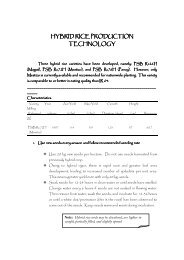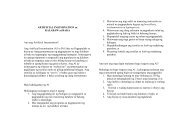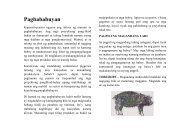You also want an ePaper? Increase the reach of your titles
YUMPU automatically turns print PDFs into web optimized ePapers that Google loves.
<strong>GROWING</strong> <strong>BANANA</strong><br />
One of the most widely grown fruit-bearing plants in the Philippines, banana (Musa<br />
sp.) ranks second only to coconut oil as a major dollar earner in terms of value in the last five<br />
years.<br />
In 1993, banana topped (in terms of production) other export crops like pineapple<br />
and mango. Banana export reached 1.2 million mt valued at $215 million in 1994; 1.21<br />
million mt valued at $224 million in 1995; 1.25 million mt valued at $236 million in 1996;<br />
1.14 million mt valued at $217 million in 1998; and 1.31 million mt valued at $240 million in<br />
1999.<br />
Indigenous to Southeast Asian countries, banana thrives best in a warm and humid<br />
climate. Of the 57 banana cultivars (varieties) found in the region, five are commonly grown<br />
in the Philippines:<br />
1. Saba, which grows to about 20 feet high and bear fruits with thick green peels<br />
when unripe and yellow when ripe with white flesh. It matures in 15 to 16<br />
months.<br />
2. Lacatan that grows to 5-9 feet high and bears round, seedless fruit with thick<br />
peels that turn into yellow-orange color when ripe. It bears fruits in 14 to 15<br />
months after planting.<br />
3. Latun<strong>da</strong>n grows up to 6-10 feet high and bears round fruits with thin peels that<br />
turn yellow when ripe. It matures and bears fruits in 12 months after planting.<br />
4. Bangulan matures in 12 months and bears round, very green with thick peels<br />
and seedless fruits which easily rots. Its fruits remain green when ripe with<br />
white flesh.<br />
5. Cavendish grows 5-10 feet high and bears export quality fruits green peels that<br />
turn yellow when ripe. It matures or bears fruits in 6-8 months.<br />
Eight other banana varieties – Morado, Pitogo, Los Baños, Señorita, Tindok, Gloria,<br />
Grana<strong>da</strong> and Tumok – are also grown in the Philippines.<br />
Banana is well a<strong>da</strong>pted to areas with well-drained, loam soil that is rich in organic<br />
matter, an average rainfall of 4,000 millimeters a year, a temperature ranging from 27-30<br />
degrees Celsius and an altitude of 1,800 meters.<br />
When planted to a water-clogged soil, banana is susceptible to root rot. Thus, areas<br />
in the ty<strong>ph</strong>oon belt are not suitable for banana growing.<br />
Banana is usually propagated through its rhizomes and suckers. When used for<br />
propagation, the suckers should be about 4-5 feet tall and must be healthy & parasite-free.<br />
Rapid propagation of banana has been achieved through the use of shoot tip culture<br />
technology.<br />
The field to be planted should be plowed and harrowed three times. Then, holes are<br />
dug the size and depth of which depend on the kind of planting materials used. Usually,<br />
however, a knee-deep hole with 45 cm in diameter is suitable for most planting materials.<br />
Before planting, each hole is applied with 10 grams of complete fertilizer and a few<br />
grams of nematives. Depending on the local practice, banana seedlings are planted at 3-4 m<br />
to 5-7 m apart in a square or triangular system. The seedlings can also be planted in single or<br />
double rows.<br />
Suckers are planted in a vertical position in the hole. Then, the hole is covered with<br />
surface soil added with compost to enable the young banana plants to recover and grow<br />
rapidly.<br />
During the dry months, the banana plants should be regularly provided with water or<br />
irrigated (where irrigation facilities are available) possibly once a week. Where water is<br />
difficult to obtain, the best time for planting is at the start of the rainy season.<br />
The soil around the young banana plant should be regularly cultivated to remove the<br />
weeds and provide aeration. Cultivation, however, should not be done beyond six inches<br />
from the base of the banana plant.<br />
Weeds can also be controlled by planting other crops like sweet potato, legumes,<br />
vegetables and others between the rows of the banana plants. The weeds can also be sprayed<br />
with weed killers.<br />
At fruiting or inflorescent stage, the banana plants must be propped up with bamboo<br />
poles to prevent them from bending or falling down during strong winds or storms. Then,<br />
dried or diseased leaves must be pruned and disposed properly.<br />
Then, only one or two suckers must be allowed to grow on each hill. The extra<br />
suckers must be removed from the mother plants and destroyed. Too many suckers will<br />
compete for nutrients in the soil with the mother plants.
For marginal lands, apply fertilizer containing 3 parts nitrogen, 1 part <strong>ph</strong>os<strong>ph</strong>orous<br />
and 6 parts potassium. When applied to young banana plants, the rate of application should<br />
be doubled.<br />
Then, the amount of fertilizer to be applied should increase as the banana plants<br />
mature. At flowering and fruiting stage, a single banana plant needs two to three kilograms<br />
of 14-14-14 fertilizer.<br />
In areas with long dry season, overhead sprinkler, furrow or drip (trickle) irrigation<br />
may be used to provide water to large banana plantations. To prevent waterlogging, construct<br />
irrigation canals.<br />
The banana plant in the Philippines has at least 27 insect pests. Only three, however,<br />
are known to cause significant <strong>da</strong>mage on all the varieties of banana. These are:<br />
1. Pitting or Wilting disease – characterized by dry, reddish-brown or black<br />
circular or oval depressed spots on the banana leaves. The disease usually<br />
comes during rainy <strong>da</strong>ys.<br />
One way of controlling the disease is the maintenance of strict<br />
sanitation on the banana plantation. All diseased leaves should be<br />
immediately removed. Then, spray the plants with Parafungus 80WP or<br />
Fungitox 70WP.<br />
2. Moko disease – transmitted from one plant to another by insects and infected<br />
tools used on the banana plantation. Its impact on banana plants is similar to<br />
that of sigatoka. But, moko disease does not emit unfavorable odor.<br />
Banana plats infected with moko disease bear fruits with blackened<br />
inside. To prevent the disease, disinfect all tools used on the banana<br />
plantation or farm. Spray the plants regularly with Fungitox 70 WP.<br />
3. Bunchy-Top – one of the most serious disease of banana that is transmitted<br />
by banana a<strong>ph</strong>id (Pentalonia nigronervosa). During its early infection, the<br />
disease is identified by the presence of broken and continuous <strong>da</strong>rk-green<br />
streak along the secon<strong>da</strong>ry veins on the underside of the leaves.<br />
Gradually the leaves become brittle and curved prematurely.<br />
The infected leaves should be immediately removed and burned<br />
so that the disease will not affect other plants. Spray with either<br />
Parafungus 80WP or Fungitox 70WP.<br />
In severe cases of these diseases, the bunch and fingers of the banana<br />
fruits shrink and ripen prematurely. They usually develop an abnormal flavor<br />
and smell. Badly <strong>da</strong>maged leaves should be cut off and burned.<br />
Among the insect-pests that attack banana plants are:<br />
1. Banana corm weevil – this insect feeds on the sucker of the banana plants and<br />
in the process destroy the corm tissue and kills the sucker.<br />
Spraying the soil with pesticide, Bushwhack 5 EC, can control the pests.<br />
All infested corm must be removed and disposed properly. Maintain strict<br />
sanitation on the plantation.<br />
2. Fruit-peel beetle – this pest injured the peel or surface of the fruit. To prevent<br />
the beetle from attacking the banana fruits, spray with insecticide like Parapest<br />
D 400 EC the whole bunch.<br />
3. Banana floral thrips – as the name suggests, this insect attacks the banana<br />
flowers. Spray the flowers with insecticide such as Bushwack 5 EC.<br />
Regardless of variety, the matured banana is ready for harvest when its last leaf turns<br />
yellow and the fingers of the fruits bunch form an angle while becoming very round.<br />
Harvesting of the fruit bunch for each variety can be done as follows: Saba at 15-16<br />
months; Lacatan in 14-15 months; Latun<strong>da</strong>n in 12 months; Bungulan in 12 months; and<br />
Cavendish in 6-8 months after planting.<br />
To prevent the bunch of fruits from getting bruised, harvesting should be done by<br />
two persons; one to cut the banana trunk and the other to hold it from crashing to the ground.<br />
The trunk is cut in the middle and the upper part bearing the bunch of fruit allowed to fall<br />
gradually.<br />
Source: Greenfields Magazine November 2003



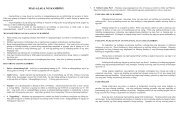
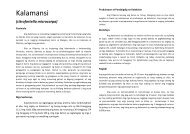
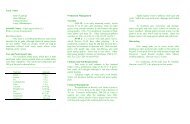
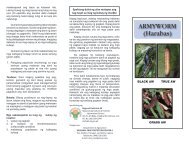
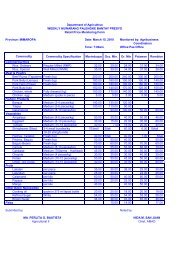
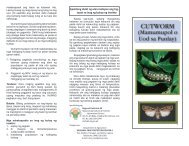
![Quick Guide-Yellow Corn Final 2-tagalog [Compatibility Mode]](https://img.yumpu.com/42848209/1/190x134/quick-guide-yellow-corn-final-2-tagalog-compatibility-mode.jpg?quality=85)


